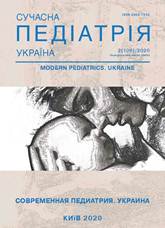Tuberous sclerosis: a clinical case in practice of pediatric nephrologist
Keywords:
tuberous sclerosis, tumors, children, diagnostic criteriaAbstract
Tuberous sclerosis is a genetic disease with multiple organs involvement and the formation of benign tumors. Diagnostic difficulties are associated with variability of clinical manifestations.
Clinical case. The own clinical observation of a patient with tuberous sclerosis with predominant lesions of the kidneys, liver, central nervous system and skin is presented. Physicians' awareness of primary and secondary diagnostic criteria, the use of additional instrumental methods, and genetic counseling contribute to the early diagnosis of the disease and prevent the development of complications.
The research was carried out in accordance with the principles of the Helsinki Declaration. The study protocol was approved by the Local Ethics Committee of all participating institution. The informed consent of the patient was obtained for conducting the studies
References
Amin S, Kingswood JC, Bolton PF et al. (2019). The UK guidelines for management and surveillance of Tuberous Sclerosis Complex. An International Journal of Medicine. 5: 171–182.
Amin S, Lux A, Calder N et al. (2017). Causes of mortality in individuals with tuberous sclerosis complex. Dev Med Child Neurol. 59: 612–617. https://doi.org/10.1111/dmcn.13352; PMid:27935023
Bissler JJ, Kingswood JC, Radzikowska E et al. (2013). Everolimus for angiomyolipoma associated with tuberous sclerosis complex or sporadic lymphangioleiomyomatosis (EXIST82): a multicentre, randomised, double-blind, placebo controlled trial. Lancet. 381: 817–24. https://doi.org/10.1016/S0140-6736(12)61767-X
Cao Y et al. (2017). Radiological appearance of tuberous sclerosis complex: a case report and review of literature. International Journal of Clinical and Experimental Medicine. 10;5: 8282–8287.
Cheng TS. (2012). Tuberous sclerosis complex: An update. Hong Kong J Dermatol Venereol. 20: 61–65.
Demir HA, Ekici F, Yazal Erdem A et al. (2012). Everolimus: a challenging drug in the treatment of multifocal inoperable cardiac rhabdomyoma. Pediatrics. 130: e243–7. https://doi.org/10.1542/peds.2011-3476; PMid:22732179
Harutunian K, Figueiredo R, Gay8Escoda C. (2011). Tuberous sclerosis complex with oral manifestations: A case report and literature review. Med Oral Patol Oral Cir Bucal. 16: e478–81. https://doi.org/10.4317/medoral.16.e478; PMid:20711158
Jankar AN, Palange PB, Purandare VC. (2014). Tuberous sclerosis — A case report. Int J Biomed Res. 5: 649–50. https://doi.org/10.7439/ijbr.v5i10.747
Koenig MK, Bell CS, Hebert AA et al. (2018). Efficacy and safety of topical rapamycin in patients with facial angiofibromas secondary to tuberous sclerosis complex: the treatment randomized clinical trial. JAMA Dermatol.154: 773–80. https://doi.org/10.1001/jamadermatol.2018.0464; PMid:29800048 PMCid:PMC6128508
McCormack FX, Inoue Y, Moss J et al. (2011). Efficacy and safety of sirolimus in lymphangioleiomyomatosis. N Engl J Med. 364: 1595–606.
Milunsky AI, Ito M, Maher TA et al. (2009). Prenatal molecular diagnosis of tuberous sclerosis complex. Am J Obstet Gynecol. 200;321: e1–6. https://doi.org/10.1016/j.ajog.2008.11.004; PMid:19254590
Northrup H, Krueger DA. (2013). Tuberous sclerosis complex diagnostic criteria update: Recommendations of the 2012 international tuberous sclerosis complex consensus conference. Pediatr Neurol.49: 243–54.
Sarkar S et al. (2016). Tuberous sclerosis complex: A case report. Contemporary Clinical Dentistry. 7;2: 236–239. https://doi.org/10.4103/0976-237X.183071; PMid:27307675 PMCid:PMC4906871
Vries PJ, Whittemore VH, Leclezio L et al. (2015). Tuberous sclerosis associated neuropsychiatric disorders (TAND) and the TAND checklist. Pediatr Neurol. 52(1): 25–35. https://doi.org/10.1016/j.pediatrneurol.2014.10.004; PMid:25532776 PMCid:PMC4427347
Downloads
Published
Issue
Section
License
The policy of the Journal “MODERN PEDIATRICS. UKRAINE” is compatible with the vast majority of funders' of open access and self-archiving policies. The journal provides immediate open access route being convinced that everyone – not only scientists - can benefit from research results, and publishes articles exclusively under open access distribution, with a Creative Commons Attribution-Noncommercial 4.0 international license (СС BY-NC).
Authors transfer the copyright to the Journal “MODERN PEDIATRICS. UKRAINE” when the manuscript is accepted for publication. Authors declare that this manuscript has not been published nor is under simultaneous consideration for publication elsewhere. After publication, the articles become freely available on-line to the public.
Readers have the right to use, distribute, and reproduce articles in any medium, provided the articles and the journal are properly cited.
The use of published materials for commercial purposes is strongly prohibited.

